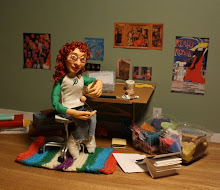Attributed to both Miss Austen and Seth Grahame-Smith, Pride and Prejudice and Zombies uses much of the original novel. The parts Grahame-Smith has added pertain (as one might expect) to zombies, the Bennet sisters training in the the fighting arts, and the plague, which has resulted in the forming of the zombies, also called unmentionables. This does not change the story line nearly as much as one might think, yet Grahame-Smith's additions are confusing; some of his additions contradict each other. The portions of narrative dealing with the undead would have been much more amusing if Grahame-Smith's back-story were solid. While we are told the Bennet sisters spent ten years in China learning the fighting arts, it is not known how this fits in with their other accomplishments nor to what extent training in the fighting arts is expected of accomplished young women.
The interior illustrations do not live up to the cover. The foreshortening is off and the anatomy skewed in a manner that does not appear purposeful. Furthermore, the costumes are not Georgian nor of Oriental derivation, and are difficult to place in any category but vaguely historic.
While an intriguing premise, Pride and Prejudice and Zombies does not live up to expectations of comedy and satire. It might be seen as beach reading, but only if one's stash is rather depleted. It may be the medium that prevents Pride and Prejudice and Zombies from reaching satirical heights; it would make a very good bad movie. With romance, period costumes, and witty dialogue for the chick flick lovers and zombies, blood, guts, gore, and Katanas for the action crowd, Pride and Prejudice and Zombies could be next summer's block-buster.
